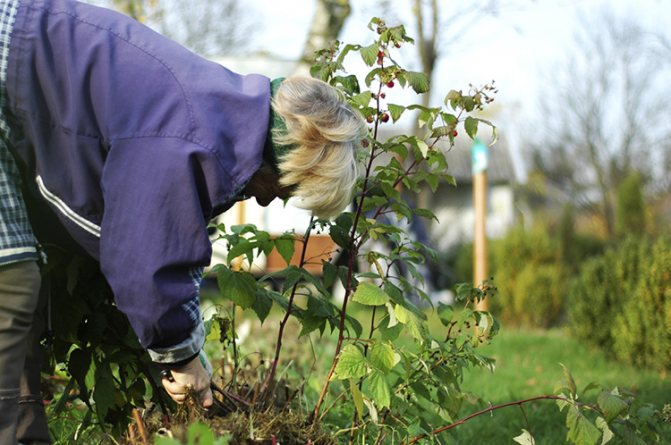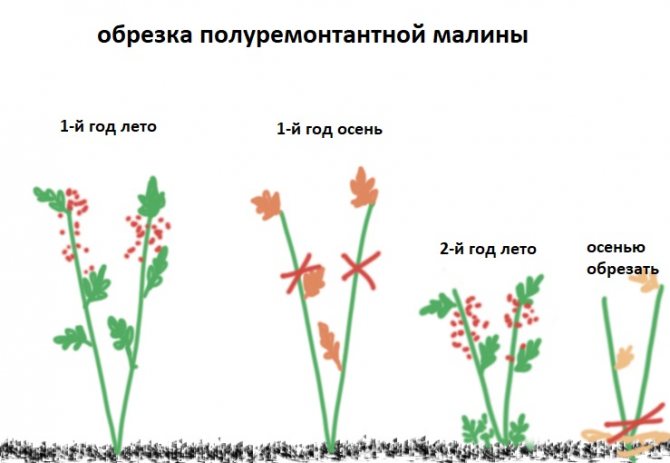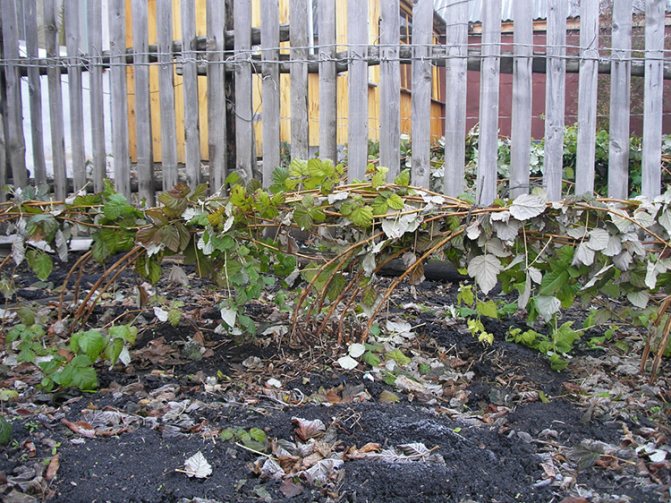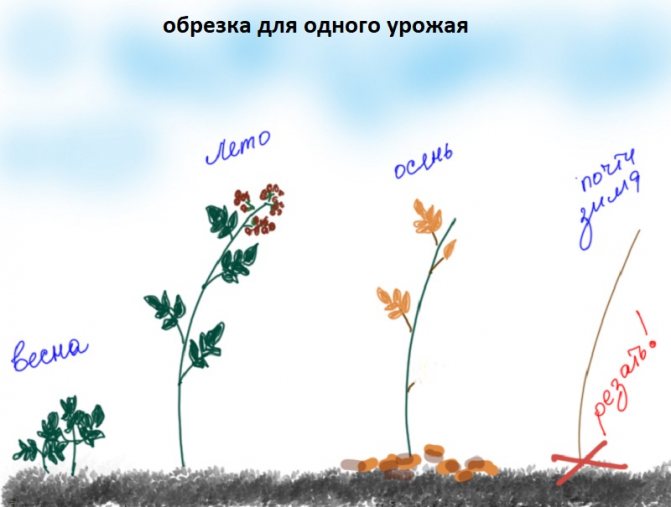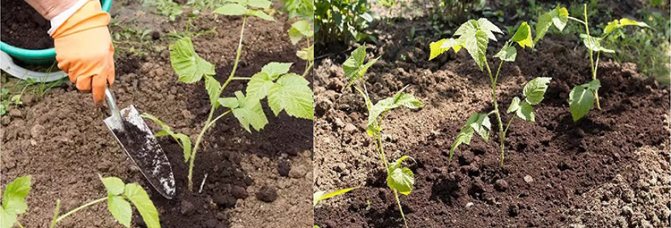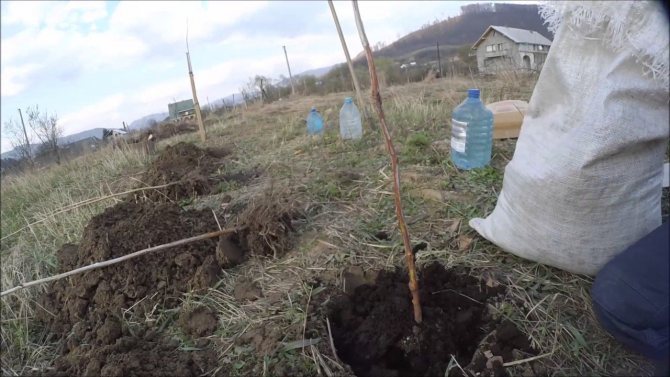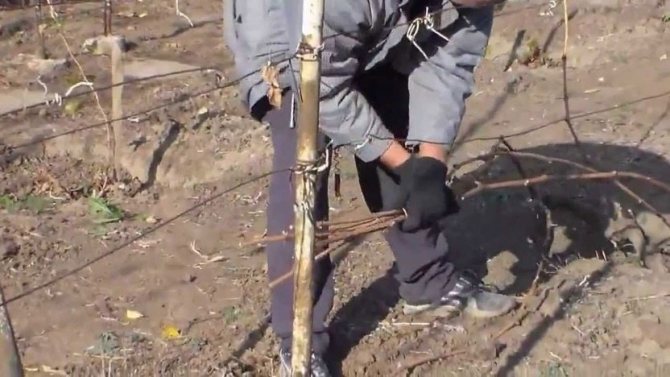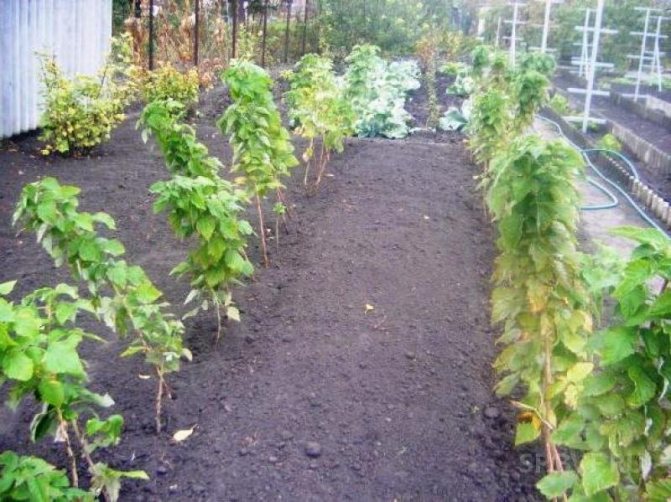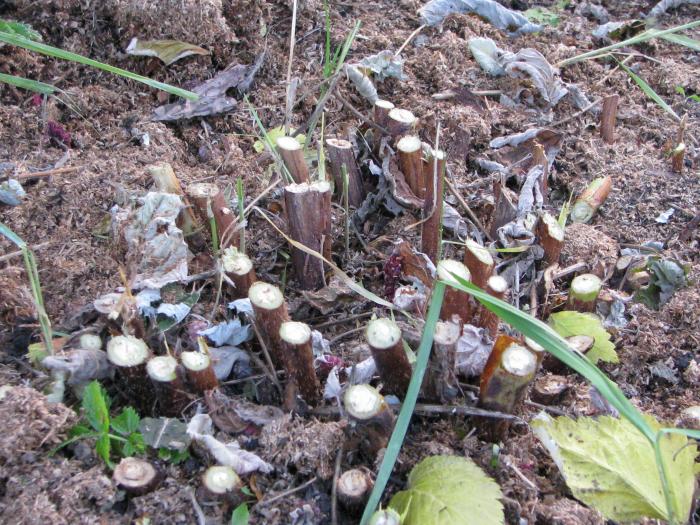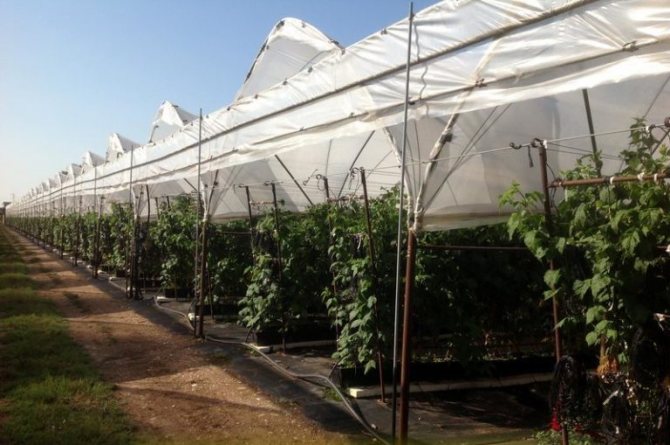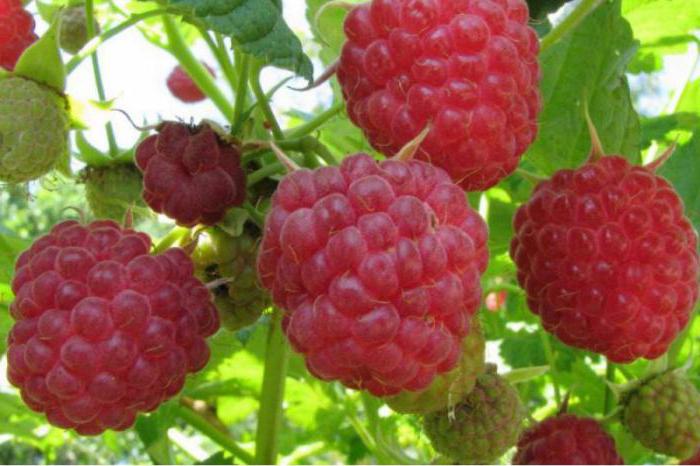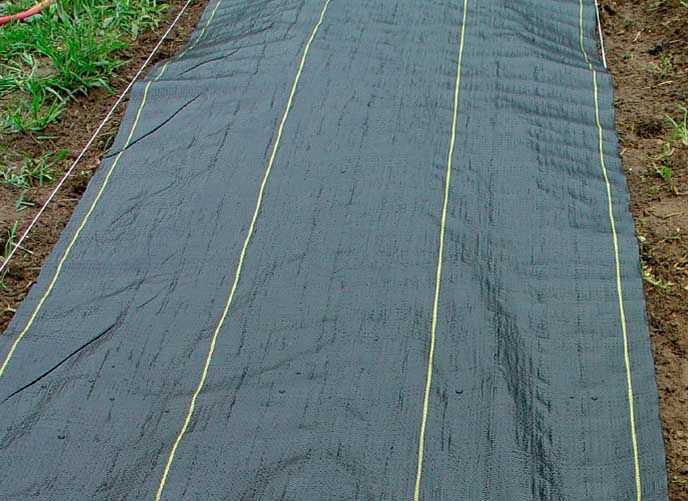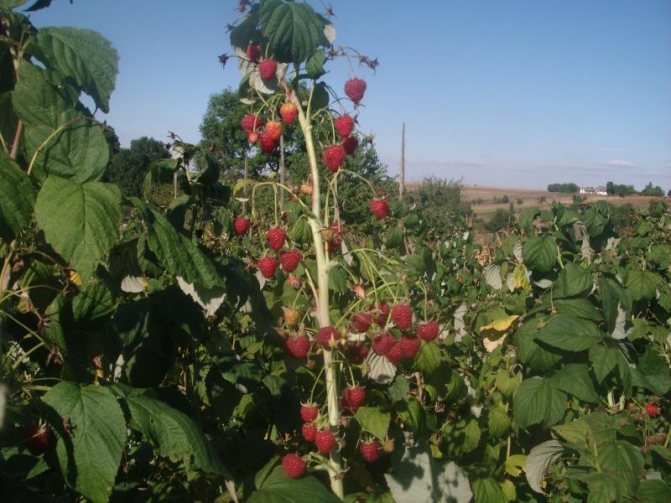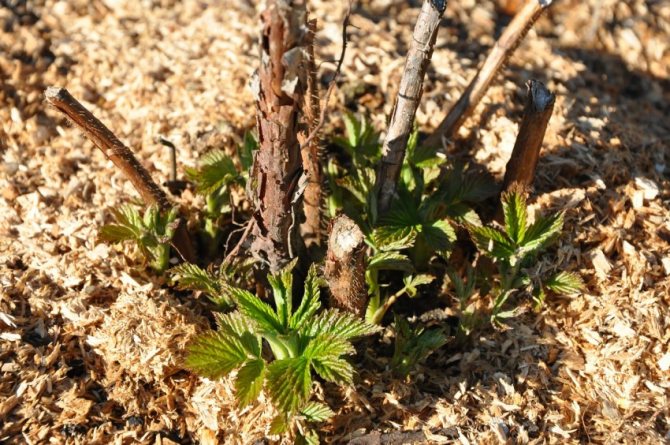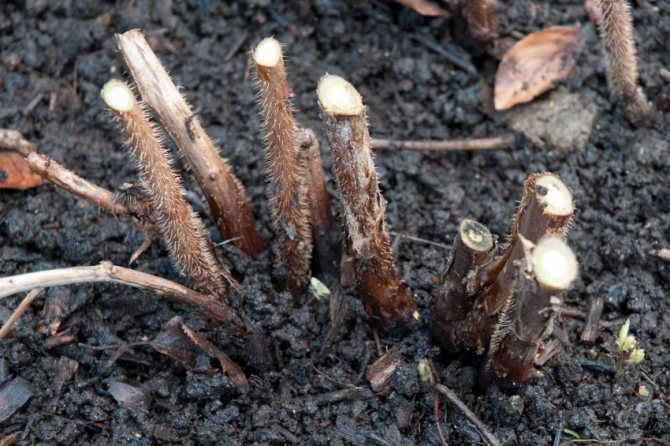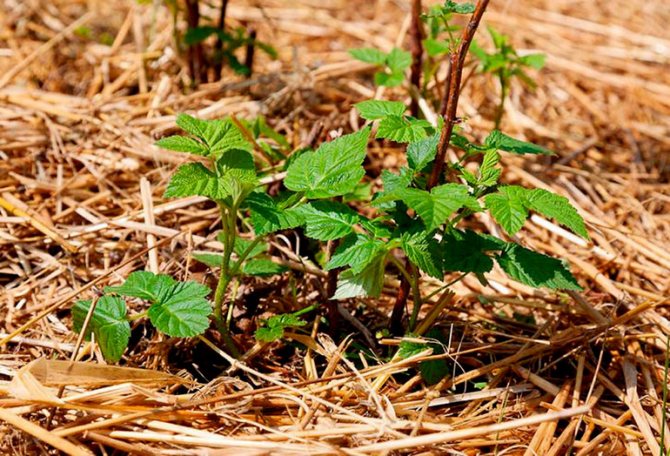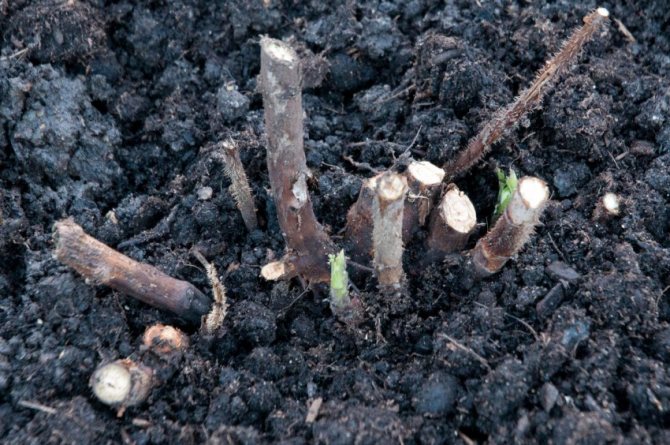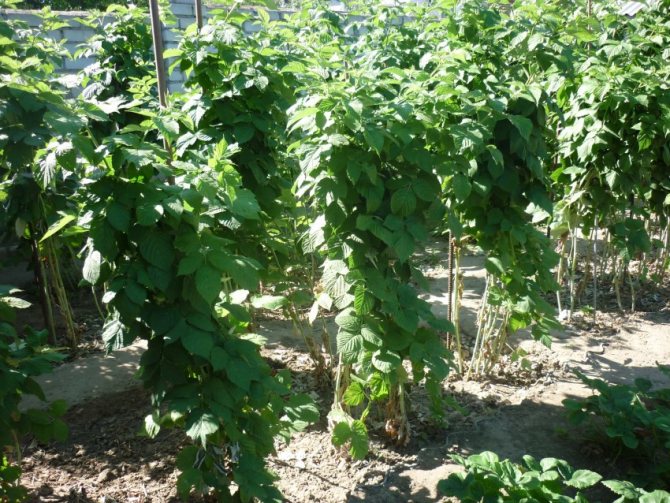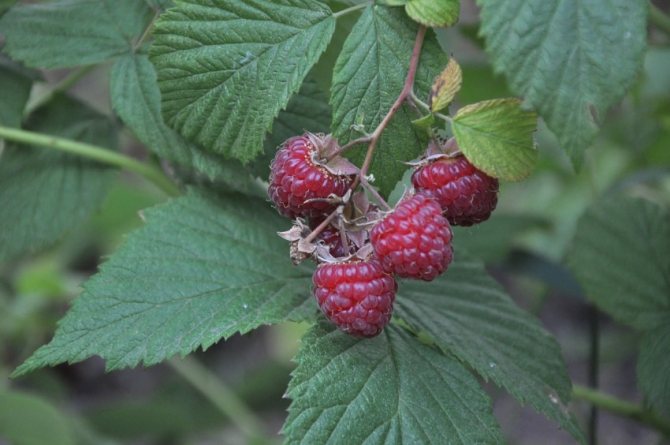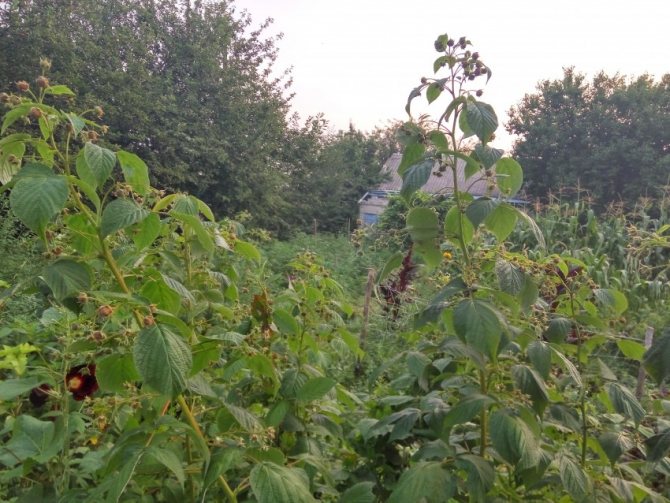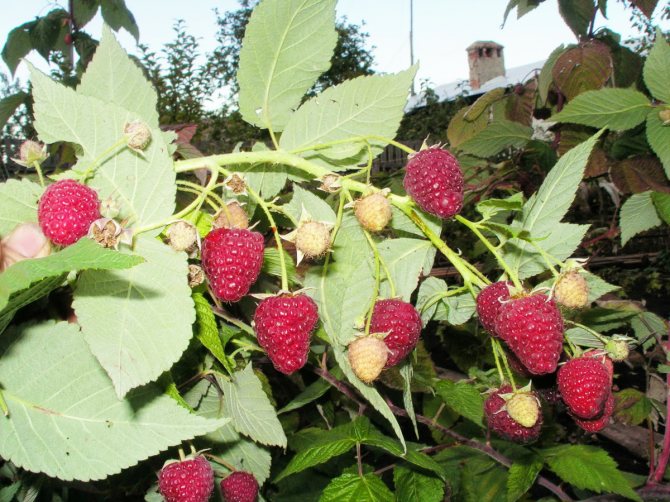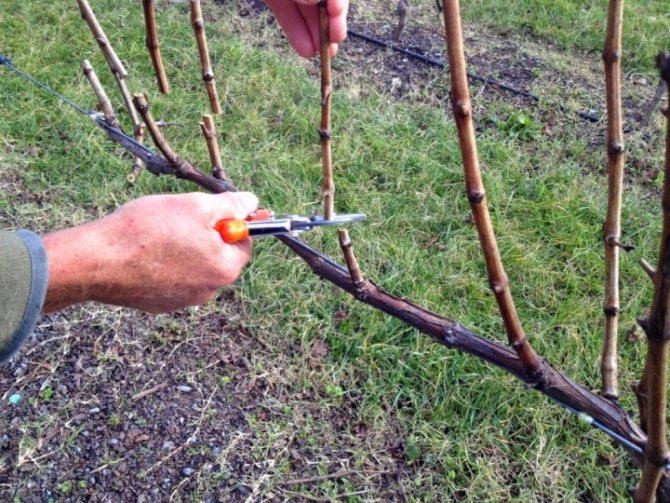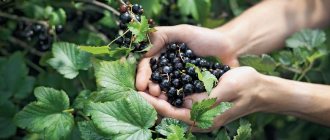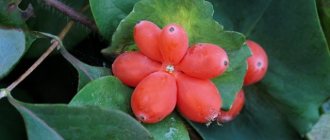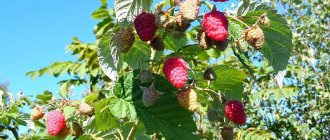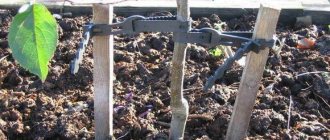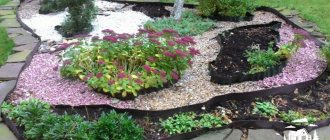Raspberry fruits are famous not only for their excellent taste, but also for their healing and strengthening properties. Raspberries grow in almost every summer cottage or personal plot. People especially love to plant varieties of remontant raspberries. They give the crop several times per season, but for this, remontant varieties need to be provided with proper care and pruning in the fall.
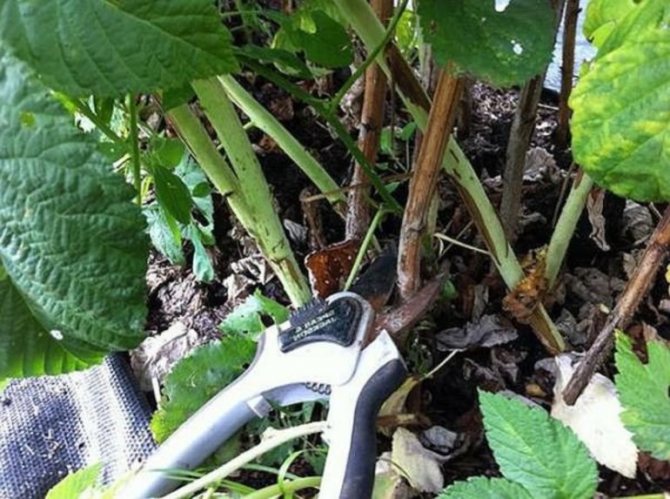
Autumn care rules
It is in the autumn period that the bushes need abundant nutrition. The repairing group of varieties bears fruit twice a season, therefore, care for such raspberries in the fall, preparation for winter is carried out later, just before the colds.


Top dressing
After the second harvest, the plant needs additional feeding to lay new buds. She will provide the bush with new strength before wintering. If you do not feed the raspberries, then next year there will be few berries.
It is recommended to add additional nutrients after pruning the bushes, in September, so that the fertilizer has time to be absorbed by the soil and plant before the winter period. In autumn, the soil is fed with humus and mineral fertilizers. For late feeding, experts recommend:
- Potassium salt or superphosphate will help raspberries survive the winter well. Potassium is laid in the soil to a depth of 7-10 centimeters in the amount of 40-50 grams per bush. Superphosphate is applied 5-7 centimeters in the amount of 50 g per bush.
- Agricola for berries. A good composition for caring for raspberries in the fall, preparing for winter. An economical tool, one package (50 g) diluted in ten liters of water is enough to water at least twelve bushes.
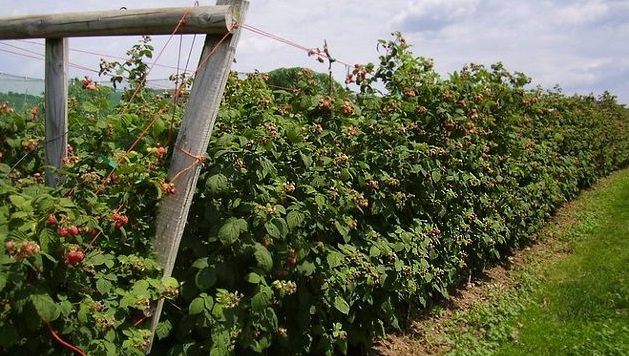

How and what to mulch
Before processing, the soil must be freed from weeds and loosened. As a mulch, both organic material and inorganic materials, such as black spunbond, are perfect.
It is necessary to cut the sheet into strips 40 centimeters wide and lay along the raspberry tree on both sides. The material can be fixed with metal pegs. This will help completely get rid of spring weeds as they will not be able to germinate through dense cover.


Organic materials for mulching work with straw, grass or peat. The mass is laid in a dense layer under the bushes.
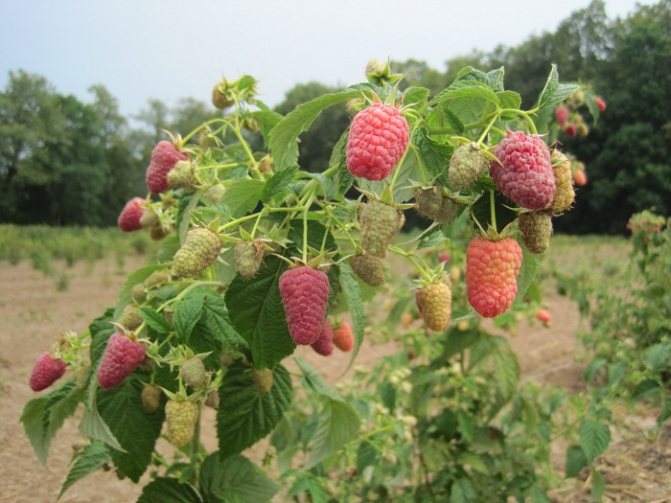

Pruning and watering in the fall
Proper irrigation is essential for good growth, and the bushes need sufficient moisture. Even if the plant no longer bears fruit after two summer harvests, it still needs to be watered, especially if it grows in the southern region. Irrigation should be moderate. Before the winter period, it is recommended to water abundantly so that the water goes into the soil by about half a meter.
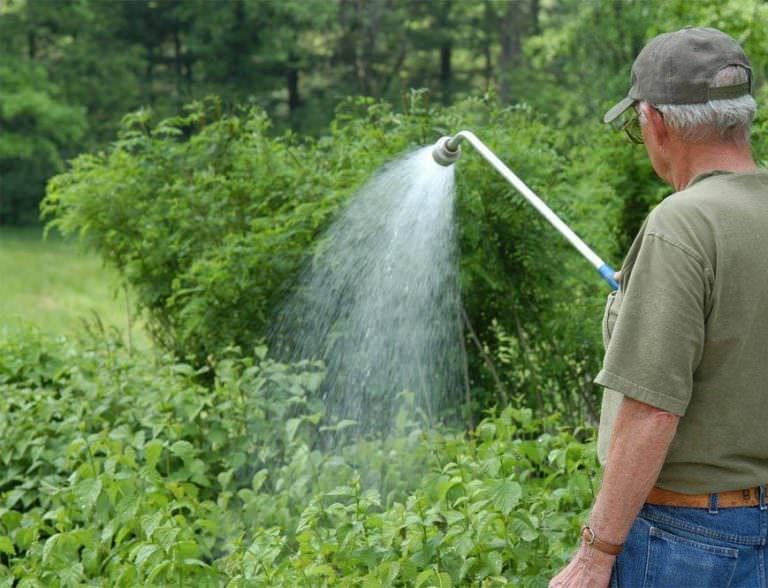

Pruning is done in the fall, preferably in September. This is an important step in leaving before hibernation. There are a few basic guidelines to follow during the pruning process.
- It is necessary to cut out already fruiting shoots in order to get two good harvests in the next season.
- Cut off bad branches.
- In order to avoid the appearance of pests, branches are removed at the root.
- After pruning, the leaves are cut off and destroyed outside the raspberry tree. This is necessary to prevent decay.
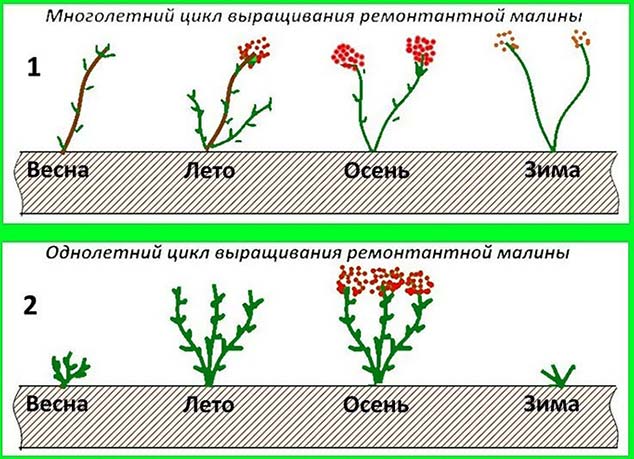

Basic rules of care
In the fall, it is necessary to reduce the amount of watering and fertilization before winter - this will increase the immunity of the bush and help withstand frost.
Watering
Since October, a pre-winter regime is gradually introduced for the raspberry bush and watered not as often as in summer, reducing the volume of water by 2-3 times.
The basic rule is to moisten the soil layers to a depth of at least 0.4 m.
Top dressing
Autumn nutrition does not consist in enhancing growth, but in maintaining a plant weakened by fruiting before winter.
At the end of the growing season, fertilizers are applied, which contain phosphorus and potassium, but little nitrogen.
It is better to use nitrogen-containing complexes in the spring. Before winter, they are avoided so as not to activate the build-up of green mass.
The basic rule is to apply top dressing after watering and after pruning.
The norm for potassium, superphosphate mineral compositions is 1 tsp each. per shrub.
Additionally, the soil is fertilized with humus, 10 liters per plant. When growing raspberries on sandstones, the amount of nutrients can be doubled.
Treatment of remontant raspberries from diseases and pests
Diseases of the raspberry bush are different, the patient's leaves, shoots, branches, and sometimes roots change. The most common diseases:
- Anthracnose. The leaves begin to curl. In this case, treatment with a solution of boric acid and the introduction of ash into the soil will help. Diseased leaves must be cut off.
- Chlorosis. Caused by pests. Signs - rapid wilting of leaves, their yellowness. In this case, the plant must be destroyed by digging and burning.
- Curliness. This is a viral disease, it cannot be treated with any treatments, the bushes are dug up and burned.
- Mosaic. A viral disease is not cured, the plants must be destroyed.
- Throat of roots. You can observe swelling on the processes of the root system. On the plant itself, the foliage turns yellow. In this case, root treatment with copper sulfate (1% solution) will help.


Since many diseases cannot be cured, raspberries need regular prophylaxis. Processing before wintering is especially important, because the plant weakens before frost. Pests also attack bushes and can destroy them. The main types of insects:
- Aphid. Drinks juice. It can be found at the bottom of the bush. It is destroyed by karbofos, they do it in early spring, before the formation of buds.
- Stem fly. The shoots begin to dry out. To get rid of it, be sure to mulch the soil and treat it with karbofos.
- Weevil.
- Raspberry beetle.
- Spider mite.
Some preventive spraying of shrubs is carried out twice a year, in spring and autumn, but most treatments should be done as early as possible, before bud break. Spring treatments are carried out when the air temperature rises to +5 degrees, and in the fall the bushes are sprayed after pruning.


Copper sulfate. The product itself is poisonous, therefore it requires special care. It is one of the most effective substances for the prevention and control of brown spot, septosporosis, anthracnose, moniliosis, fruit rot.
Only adult plants are sprayed with 1% copper sulfate. Less poisonous remedy based on vitriol - "Kuproskat" or "Hom", they are more expensive than vitriol, but not so harmful to humans.


Inkstone. Effectively fights insects, scab, gray mold, mosses, lichens. Suitable for the prevention of chlorosis.


For treatment against pests, 500 grams of vitriol is bred in a ten-liter bucket and the soil is spilled. The processing time is early spring (before bud break), autumn (after pruning the plant).
For the prevention of diseases, raspberry bushes are sprayed in the spring, three times, every five days. To make a solution, 30 grams of vitriol is diluted in a ten-liter bucket.
Features of remontant varieties of raspberries
Such raspberries bear fruit twice a year and this is what attracts many gardeners.The first harvest ripens on last year's shoots, the second - on young ones that have grown from the root in spring, and berries from the second harvest can be harvested until frost. They hang on the branches for a long time without crumbling. Repaired raspberries give a small number of replacement shoots, which also makes adjustments when pruning it.
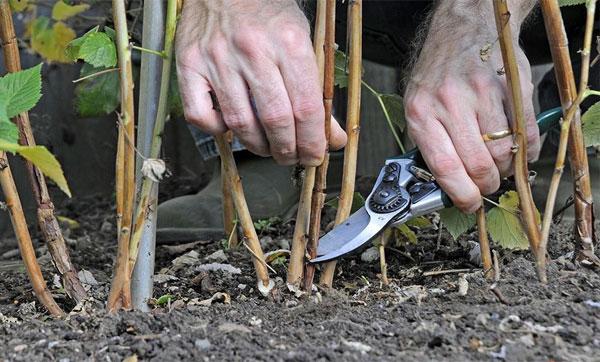

However, 2 full-fledged crops can be obtained only in a temperate climate, in the northern regions the last berries often do not ripen, they remain green on the branches, therefore, growing 2 crops in such an area is not profitable. It is best to prune raspberries so that they yield 1, but more bountiful harvest.
Preparing remontant raspberries for winter
It is important to take care of the preparation for winter in advance, the quality of growth and fruiting for the next season depends on this process. Care for remontant raspberries and preparation for winter in Siberia and northern regions should begin earlier than in warmer regions.
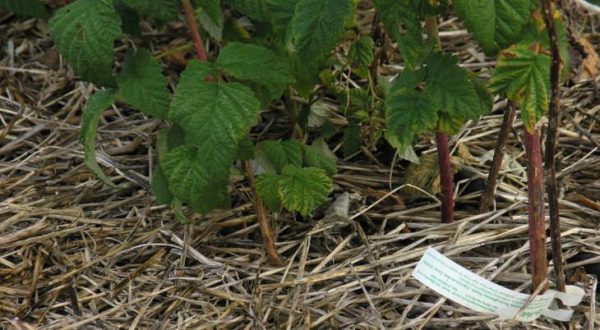

Bushes before the winter period are applied to the ground and take cover. In the northern regions, they are densely covered with snow. In areas where there is little snow, any covering material (for example, cardboard, film) is used.
In general, caring for remontant raspberries and preparing for winter are not difficult, but if something is unclear, we recommend watching a video where everything is clearly shown.
Repaired raspberries can be safely attributed to the most popular and well-known varieties. Proper care of her bushes makes it possible to harvest rich crops twice a season. The peculiarities of this variety of raspberries are not only in its yield, but also in the technology of processing plants.
Caring for remontant raspberries in autumn is significantly different from caring for summer varieties. To get large yields, it is necessary to adhere to clear recommendations for care not only in the spring and summer, but also in the autumn.
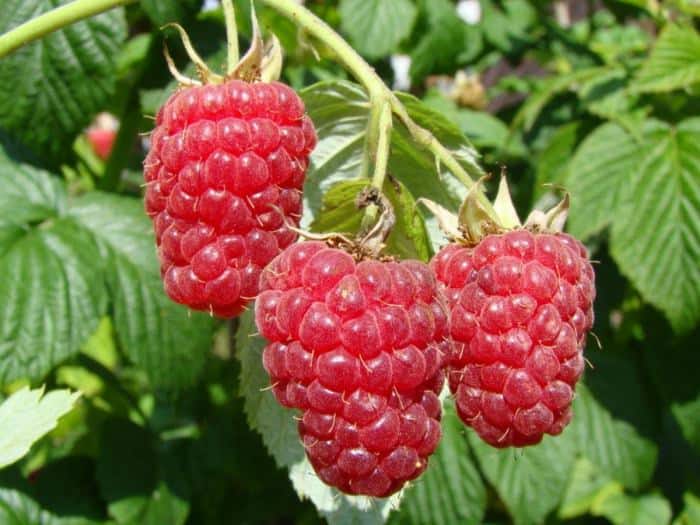

Rules for planting and caring for remontant raspberries
Remontant raspberry bushes are in many ways similar to conventional varieties. They are also perennials.


Repaired raspberries should be planted in a sunny area.
If a decision is made to breed remontant varieties of berries, then it is important to remember that the soil for planting must be prepared in advance. The plant loves a light soil, but fertilized with useful minerals. In addition, it is recommended to choose a site that is sunny and protected from drafts.
You can plant seedlings both in spring and autumn.... If we talk about the spring period, then it is important to remember that the soil will have to be prepared in the fall. To do this, you need to dig up a bed, enrich it with compost and mineral fertilizers. In the spring, planting begins from March to April, depending on the region and climatic conditions.
In the prepared area, they dig holes with a depth of shovel bayonet at a distance of 70 cm , it is recommended to leave at least 1.5 m between the rows. The thing is that the bushes will grow over time, the rhizomes need enough space. Seedlings of future shrubs are checked before planting, they make sure that the root system is well developed, and the stem itself turns green and has healthy buds.
Disembarkation rules
The plantings are immersed in a prepared hole and sprinkled with fertile soil, while it is important to pay attention to how the roots are located.
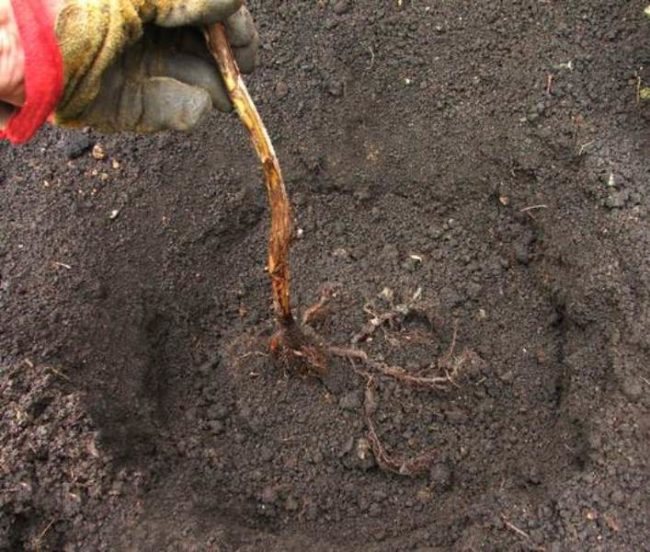

Before planting, you need to prepare a hole for the raspberries.
They shouldn't be too deep. But it is also recommended to trample the ground a little so that the rhizomes fit snugly against the ground. After that, you need to water the future bushes abundantly.
If a decision is made to plant remontant raspberries in the fall, then you should remember that this should be done in late September or early October. In this case, the meteorological features of the region should be taken into account, since during this period the first frosts may begin. As for the preparation of the soil, the site is prepared in spring, digging it up and adding the necessary fertilizers, depending on the composition of the soil.
Care and proper preparation for winter
With the onset of autumn, remontant raspberries continue to bear fruit and delight with abundant harvests. Caring for the bushes of this variety and preparing them for the winter season takes place much later.
It is important to know how to process berry bushes so as not to harm them, but, on the contrary, to achieve high yields.
Each type of raspberry has its own care requirements. Before you start growing remontant varieties, you should carefully study the basic rules for care. Theoretical knowledge and practical experience help to harvest good yields of juicy and sweet berries every season.
Treatment of diseases
If the plantings are very thickened, the ground is constantly wet and does not dry out, and last year's leaves have accumulated at the base of the stems, there is a danger of development:
- anthracnose;
- gray rot;
- rust;
- spotting;
- mosaic;
- stem and root cancer.
The first symptoms of most diseases are a change in the color of the leaves, their wilting or twisting, the spread of colored spots on the surface, in the place of which dried patches or holes later appear. Swelling of the stem, the appearance of cobweb strings, rotting of fruits and ovaries should also alert.
The main pathogen belongs to fungi, but there are also bacterial causes. For preventive purposes, they are sprayed with Bordeaux liquid and copper-containing preparations.
It must be remembered: chemicals have a certain period during which processed fruits cannot be eaten. It is better to give preference to folk remedies and competently care for the bushes.
Watering and feeding
Watering plays an important role for the growth and fruiting of bushes. Raspberry is a moisture-loving plant, therefore it is necessary to carefully control the depth of soil moisture, it should be at least 40 cm.
Watering frequency is adjusted according to running and climatic conditions. In dry periods, the bushes are watered abundantly and often. With frequent rains, they refuse additional watering.
The most important period in which raspberries require particularly careful care is considered to be the time of flowering and ripening. These days, the bushes are watered regularly and the moisture of the ground is carefully controlled. Continue watering the raspberries after harvest.
It is very important for remontant raspberries to get plenty of nutrients and minerals. This is especially true for the period of appearance and ripening of fruits. Organic and mineral substances are used for feeding. The most effective use of such fertilizers:
- phosphorus substances;
- fertilizers containing potassium;
- semi-rotted manure;
- solutions from liquid mullein or chicken manure diluted with water.
During the entire growing season, several feeding sessions are carried out. In the spring, nitrogen fertilizers are used, during flowering and fruiting, mineral fertilizers. After the harvest is harvested, phosphorus-potassium preparations are more effective.
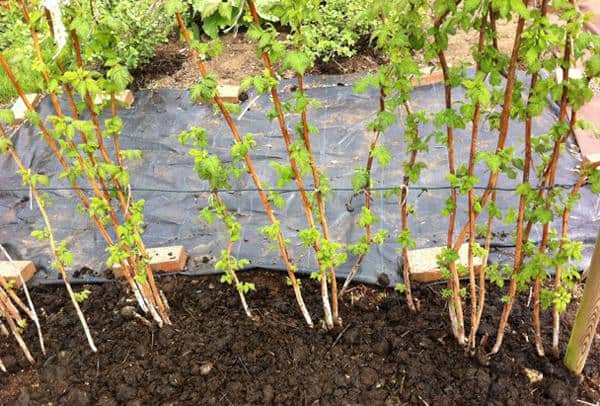

Disembarkation dates
In the Russian climate, remontant varieties are recommended to be planted in the last week of September or at the very beginning of October. If you do this on time, then the plant will be able to prepare for the winter cold. It will also allow the raspberries to start growing actively during the spring months.
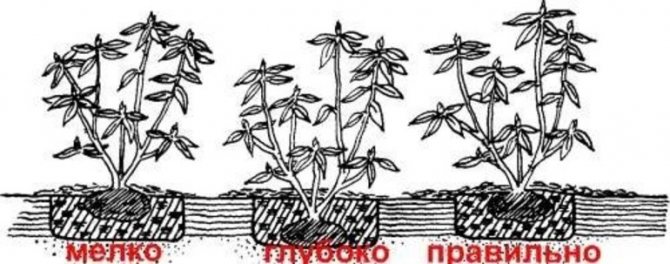

It is better not to carry out this procedure before the deadline, since experts say that by the beginning of September the plant has not yet fully formed the root system. Because of this, raspberries may simply not take root. Repaired varieties are famous for the fact that they are able to grow well in rather harsh climatic conditions. Wherein fruiting remains at a high level.
Helpful!
You can plant raspberries in the spring and summer months, but remember that all seedlings should be wrapped in sawdust, snow or straw for the winter. This will preserve the roots even in severe frosts.
Plants need to be planted either in a straight row or in separate bushes. A minimum gap of 1 meter between seedlings should be adhered to. The pits for the future bush should be shallow. It is also advisable to treat the plants with special fertilizers. After disembarking, it is necessary to compact the ground well.
Shelter and mulching for the winter
It is very important to prevent raspberry bushes from freezing and to protect them from winter frosts. To do this, the lashes are bent closer to the ground using arcs or driven pegs. Warming should be done in regions with cold, but little snowy winters. Elsewhere, snow can act as insulation.
In most regions where remontant varieties of raspberries are grown, the bushes are covered for the winter. To do this, use various improvised means:
- film;
- peat;
- thick paper or cardboard;
- Styrofoam.
The material that is used as insulation must allow air to pass through so that the plants do not rot. To prevent this from happening, special holes are made for ventilation.
Mulching berry bushes in late autumn is beneficial for plants:
- the roots of plants are protected from the cold, and the soil is insulated;
- moisture is retained in the soil.
For mulching, dry hay, peat or collected fallen leaves are used. It is necessary to do it before the first snow. The height of the laid out layer should not exceed 7 centimeters, otherwise the root system of the plant will begin to rot and the raspberries may die.
Historical reference
According to the official version, remontant varieties began to be grown in Russia about 30 years ago, but people learned about them much earlier. About 200 years have passed since the first description of raspberries, which differed in that in August flowers began to appear on annual branches, which then became berries. In the southern regions of the country, these raspberry varieties were sometimes found. A. Michurin bred the "Progress" variety, which was distinguished by the fact that under favorable conditions it gave a small harvest in the autumn period.
Unfortunately, up to the end of the 70s of the 20th century, no one was engaged in breeding remontant plant species in Russia. Only Professor Kazakov was able to contribute to the development of this direction.


The newest varieties are:
- Eurasia.
- Golden autumn.
- Atlant.
- Diamond.
Fact!
They differ in that they have high quality berries and excellent productivity in the autumn.
Overgrowth control
Healthy raspberry bushes use a lot of nutrients for growth. This harms plant growth and fruiting. If raspberries are not bred, then new shoots are removed with a sharp shovel.
It is customary to remove all new shoots that appear at a distance of 20-25 centimeters from the main root of the shrub. If the shovel is stuck at an angle into the ground, the extra shoots can be easily removed. This procedure is very important, since the plant will give all its strength for growth and flowering. Removing excess growth significantly increases the yield.
Pruning process
Many novice gardeners often ask the question: "When and how to properly prune remontant raspberries?" This type of berry bush requires special care. For abundant fruiting, it is recommended to leave up to 3 stems per m2.
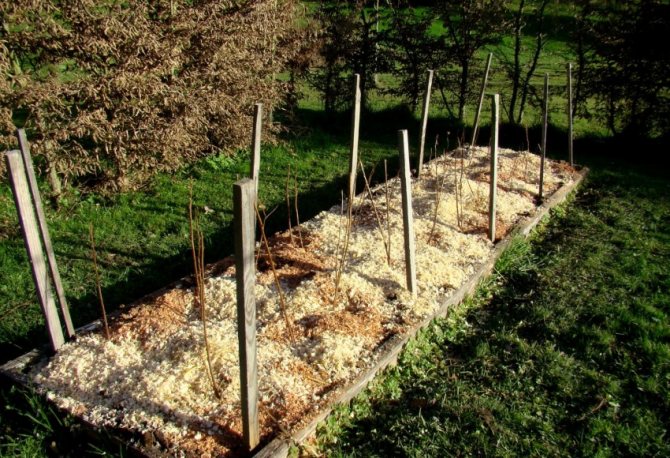

How to prune remontant raspberries? This process takes place in several stages. The initial pruning is carried out already in the first year of the plant's life. In the second year, a similar procedure is repeated to achieve the desired result.
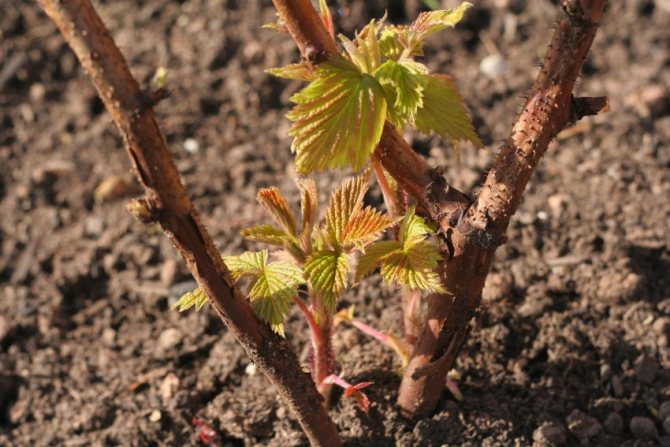

Pruning remontant raspberries in the fall
Caring for remontant raspberries in the fall has some peculiarities. One of them is correct pruning.
Inexperienced and novice gardeners believe that pruning should be done only to thin out the bushes. Raspberry, a plant with a two-year development cycle. In the third season, the size of the fruit is significantly reduced. Therefore, you have to completely remove the shoots.
Autumn pruning makes it possible to pick large and juicy berries next summer.
There are several reasons for pruning raspberries in time:
- Usually parasites and pests like to settle on the top of the shoots or on dry branches. They hibernate in the ground, and with the onset of warm days, they begin to become more active. Pruning is the most effective way to get rid of harmful insects, as well as a good prevention of their appearance. Correctly executed autumn pruning removes pests along with the trimmed parts of the shrub.
- It is an aid in the fight against various diseases.
- Increases productivity.
In conventional varieties, pruning stimulates the development of biennial shoots. This is done so that the variety does not degenerate. At the remontant raspberry, first-year plants bear fruit.
In order for young plants to have new shoots for the next season, a good rest is necessary for the raspberry bushes. To do this, they are engaged in pruning cuttings - thinning the bushes ensures the penetration of sunlight to the fruiting branches. This has a beneficial effect not only on the yield, but also on the growth of the plant.
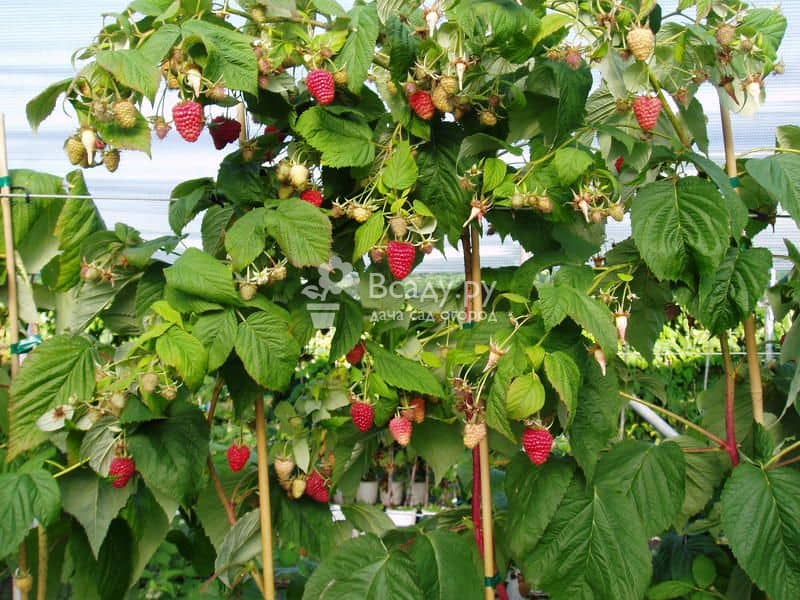

Pruning features
Repaired varieties differ in that the root system is located on the surface. This necessitates increased attention to the ground.
Advice!
You can remove all weeds by mulching the soil. Also, a very important point is watering the plant - there should be enough moisture throughout the entire fruiting period.
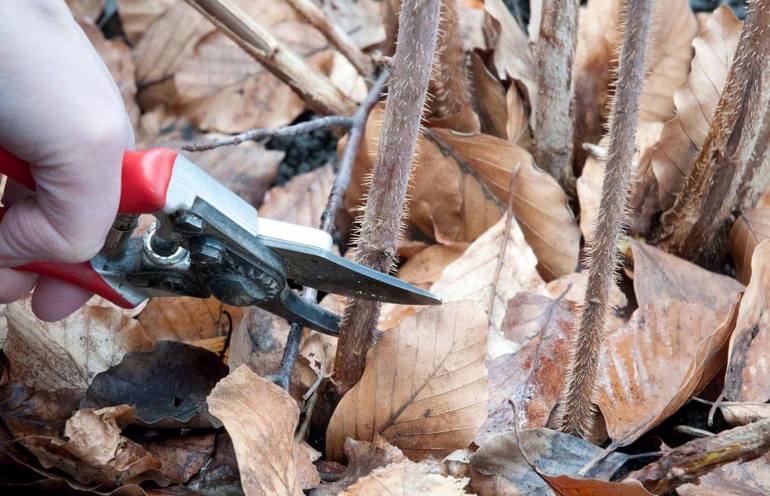

To improve the quality and quantity of berries, you need to regularly and on time to feed the bushes with complex fertilizers. The most suitable time is March. Superphosphates are best, but potassium sulfate can also be used. To prevent the occurrence of fungal diseases, you need to treat raspberries with Bordeaux liquid.
Bushes begin to produce berries about 2 years after planting. Sometimes raspberries yield only one crop per season, sometimes two. But the second fruiting is always of lower quality, so you need to correctly follow the recommendations for caring for remontant raspberries in the fall. Pruning must be done so that the bush does not overgrow.
Important!
It is undesirable to leave annual branches for the next year. They should be cut to a size of 30 mm. Pruning should be done between October and mid-November. This procedure will have a good effect on the next crop, and will also make the bushes less susceptible to disease and cold.
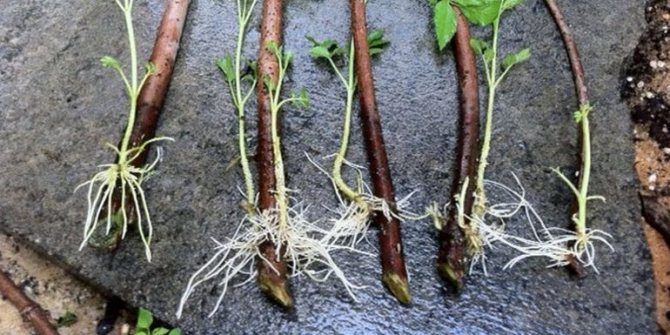

You may be interested in:
Propagation by cuttings and planting raspberries in the fall Raspberries are a berry loved by adults and children. It attracts with its sweet taste and pleasant aroma. It is used to prepare ... Read more ...
Shrub age
According to many gardeners, the first pruning of remontant raspberries should be done when the plant reaches two years of age. If final processing is carried out, then it is necessary to cut off all branches that have given a high yield near the base. You also need to remove young roots.


If the variety is planted for breeding, then total pruning must be performed. It involves cleaning all the roots. In this way, protection against various pests and diseases can be increased.
The autumn period before the first frost is best suited for this operation. If you do not prune the branches to the base, then new shoots will not develop. In addition, the plant will lose its remontant properties, that is, it will not be able to bear fruit again.
It is necessary to take special care in caring for remontant raspberries in the fall - this is a guarantee that the yield will remain at a high level. All remontant varieties have three phases of development:
- Height.
- Branching.
- Fruiting.
All these phases take place in one season, so raspberries need to be thinned several times a year.This will allow the branches to get enough nourishment and gain strength.
Important!
The main rule of care is timely pruning. Two-year-old branches must be completely removed after picking the berries. New shoots should be kept under control. Double pruning in central Russia is not required, because the berries will not have time to ripen in the fall.
The time for cutting raspberries for the winter depends on the desired number of crops - one or two. If you intend to collect the berries twice, then you need to cut off the branches in late autumn. It should also be remembered that only those shoots from which the crop was harvested need to be removed. If one berry collection is enough, then the procedure can be carried out earlier. In this case, you should cut off the shoots almost to the level of the soil.
Pruning technique
Pruning raspberries is a very critical moment. It is necessary to act strictly according to the scheme:
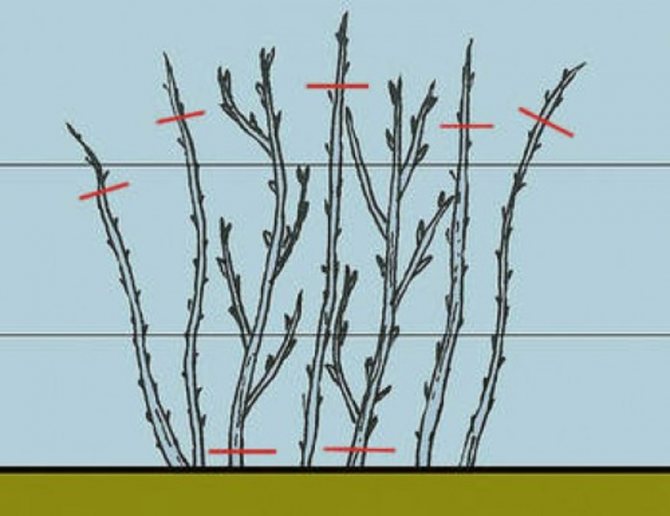

- First you need to remove the young and old branches. You should carefully cut off the dried shoots from which the fruits have already been collected. You must cut them right at the root. This will reduce the likelihood of infectious diseases, as well as insect damage.
- Young shoots should also be removed as they have no function. Only strong shoots need to be cut - they are shortened to 30 cm.
- You also need to chop off the trunks - this will not allow the shrub to overgrow too much. It is necessary that there is a minimum gap between the plants that will allow them to grow comfortably.
- Cleaning of leaves. Taking care of the leaves is also part of caring for raspberries. In order not to harm the kidneys, they must not be torn off. You can put on a glove and gently run your hand along the trunk - the old leaves will fall off by themselves. It is undesirable to leave them, as the process of decay will begin, which will damage the kidneys.
- Bushes bend to the ground. After trimming and harvesting the leaves, bend the raspberries. This will protect the upper areas from frost.
Helpful!
After all procedures, it is necessary to additionally treat the soil with a special solution that kills insects and fungi. This will provide additional safety for the shrubbery.
Shrub pruning options
Pruning is not too time consuming or difficult. It is important to know the main features of this procedure. How the thinning of raspberry bushes is performed can be seen in the video:
There are several pruning schemes:
- Shortening. This method is used for common raspberries. It makes it possible to stimulate the growth of branches in two-year shoots, to increase the yield.
- Double. It is used for all varieties of raspberries. The main purpose of pruning is to form bushes and improve their development. This scheme has its own characteristics. For less experienced gardeners, it will seem rather daunting.
- Regular. This type of pruning can be used for any type of raspberry.
The usual pruning method involves removing nearly 80% of the shoots. Cutting off common raspberries in the autumn period in height, they leave black-eyed up to 13 centimeters from the surface of the earth. The ability of plants to regenerate should be taken into account - how high the raspberry bushes grow in the spring and summer.
For remontant varieties, it is enough to leave 5-7 centimeters from the soil surface. This raspberry has good growth properties.
The operation is performed using a special garden device - a secateurs. However, you can use garden shears or a sharp knife.
First of all, the top of the shoot is cut off to awaken the dormant buds. This needs to be done in May. In the fall, they begin to trim the shoots by 1/3. For one bush of remontant raspberry, approximately 7 shoots are left.
What you need to know about pruning a plant
In general, it is recommended to cut the repairing raspberry bushes 2 times a year. The first time in the spring, when buds are formed, the second - in the fall, before the onset of frost.
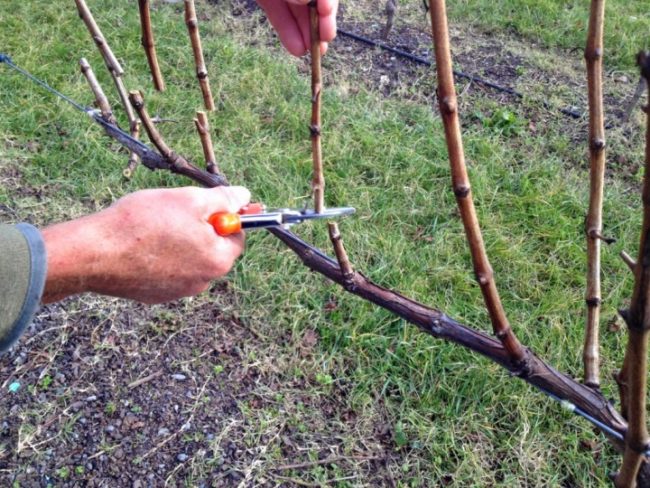

Bushes should be pruned twice a year.
After the winter period, pruning of shrubs is mandatory, because this procedure allows not only to identify damage to the branches, but also makes it possible to refine the site. It is best to prune the shrub when the buds are swollen and you can clearly see how suitable the stem is for further cultivation.
Trim Algorithm
The stem is shortened by 10-15 cm from above, leaving 3-4 healthy buds below. And also it should be remembered that in each bush it is necessary to remove weak shoots, leaving only 5-6 large shoots. It is important to use a garden pruner for pruning, which leaves a neat cut without damaging the branch.


The garden pruner does not damage the branch when used.
Step-by-step pruning
Many specialists, in order to ensure constant ripening of berries, carry out a phased pruning of raspberries. To do this, you need to divide the shoots into 3 groups:
- for large shoots, shorten the tops by 10-15 cm;
- the second group of shoots is shortened by half;
- the third is cut almost at the root, leaving 10-15 cm from the ground.
Thus, the raspberry tree forms a phased growth of the shrub during the entire fertile period. This allows you to harvest until the very cold, practically without interruption.
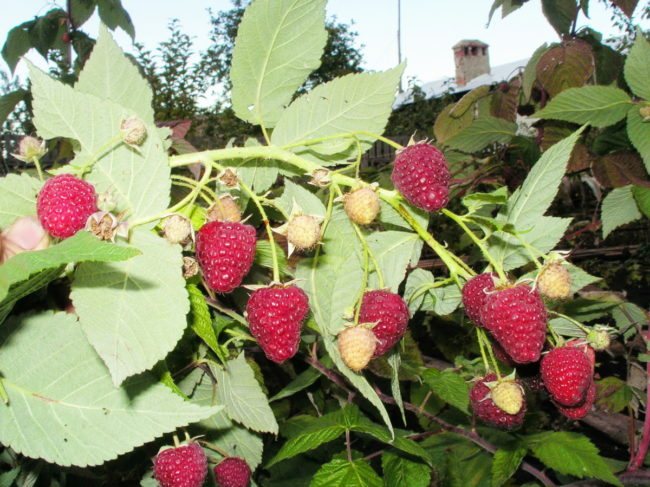

Phased pruning will extend the harvest period to cold weather.
Pruning in the fall
According to experts, the autumn pruning of the remontant raspberry is a must.


In the fall, raspberries are cut to the root, leaving 5-7 centimeters.
It is important to know that it is carried out only when the shrubs reach the age of two. After the last harvest, when the cold begins and the leaves fall off, you can carry out the autumn cleaning of the site. To do this, all large stems are cut almost at the root, leaving 5-7 cm from the ground, and young shoots are removed altogether. If you do not cut the raspberries in the fall, then in the spring new bushes will grow low, and the raspberry itself may lose its ability to maintain.
Required inventory
All instruments are prepared in advance - sharpened and disinfected. Blunt cutting parts will damage the branches, impairing the frost resistance of the bushes. And a non-disinfected tool can carry various diseases by infecting raspberry bushes.
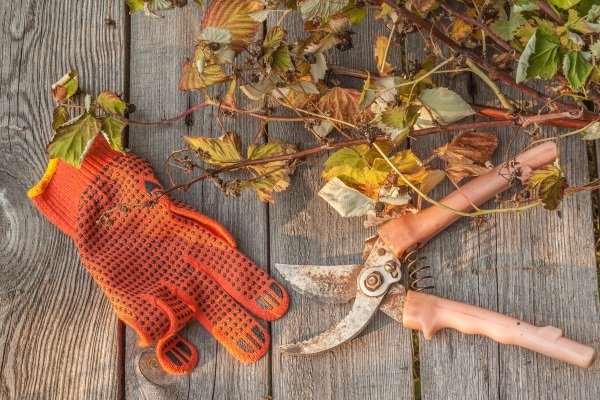

Tool required for trimming:
- Pruner. The main tool for removing unnecessary branches and overgrowth. It can be replaced with a pruning shears.
- Lopper. May be useful for cutting thick stems.
- Garden knife. Needed to correct unsuccessful, uneven trimming.
- Rake. With their help, trimmed branches and leaves are removed.
What tools are needed to trim raspberries
Full pruning can only be done with a permanently disinfected sharp pruner. A tool with dull blades will do a disservice, as it will crush and damage the branches, which will affect the winter hardiness of the entire plant. But the disinfection process is needed to exclude the possibility of transferring diseases to other shoots. Any disinfectant will do.
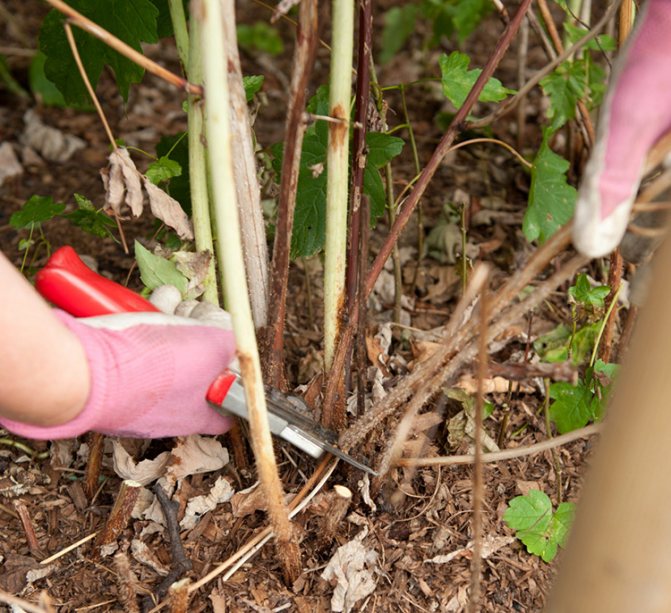

Remember to wear gloves when using the pruner in raspberries!
What is the difference between autumn pruning in different regions?
The differences in pruning are related to the climate, it is he who makes adjustments to her technique:
- In the central regions of the Russian Federation and in the Moscow region in particular, young shoots can not be cut off for the winter. It is enough to tie them up and cover them. This method allows you to use snow as a natural insulation. But the use of artificial covering materials can damage - condensation often forms under it, which provokes the development of fungal diseases.
- In Siberia, autumn pruning is a compulsory agrotechnical measure. The winters are so cold here that you can't do without shelter, and the cut bushes allow you to quickly and easily cover the raspberry tree.
- In the Krasnodar Territory, pruning is carried out in late autumn. Gardeners manage to get another fall harvest.True, autumn raspberries are small, and there are very few of them, but it's still nice when the bushes continue to bear fruit at such a late time.
Raspberries are unpretentious and bear fruit under any conditions, but if you are interested in a good harvest, in large and sugary berries, then do not be too lazy to cut raspberries in time. You should be especially careful about autumn pruning - it is important to correctly calculate the timing and observe the technique of this responsible agrotechnical event.
0
Exact terms and conditions of pruning
Autumn is considered the best time to prune raspberries. The main thing is not to postpone this event until frost. When the harvest ends, a lot of pests accumulate on the bushes - it's time to destroy them by cutting off and eliminating the excess branches by burning. Otherwise, insects will parasitize on these shoots, feeding their body before wintering.
Timeframes by region
After pruning, there is still a month and a half before frost, during which time the plants have time to accumulate nutrients for the future harvest. Table 1 shows the timing of autumn pruning for different regions of Russia.
Table 1
| Region | Pruning time |
| Middle lane | from the second decade of August to the second decade of September |
| Ural and Siberia | throughout August |
| South of Russia | from mid-July to mid-October |
Raspberries are cut no later than three weeks before the establishment of negative temperatures.
When choosing pruning times, consider the forecasts for your region. It may be necessary to adjust the timing due to the early cold snap.
Pruning time also depends on the type of raspberry:
- On ordinary raspberries, pruning is carried out after picking the berries - it is difficult to determine the exact timing in advance, you need to take into account the onset of frost.
- Repaired raspberries are in no hurry to cut - they bear fruit until late autumn. Usually pruning is done after the foliage has dropped.
Lunar dates
Pruning of raspberry bushes is carried out during the waning moon, in phases 3 and 4. During this period, the juices in plants move from the point of growth in the direction of the roots - under such conditions, pruning is most favorable. It is not recommended to prune raspberries on the full moon, new moon and on the 23rd lunar day.
In the fall of 2019, it is better to prune raspberries on such days:
- September 2, 5, 7, 9, 20 and 28;
- October 1, 4, 5, 10, 29, 31;
- November 3, 7, 8, 11, 28, 30.
3, 6 and 8 lunar days are favorable for any work, including pruning shrubs.
It is not recommended to prune the bushes:
- October 1 and 28;
- November 1 and 26.
The best days of the moon for pruning shrubs are in Aries, Leo and Sagittarius.
Fundamental rules
Autumn pruning combines the removal of infected, damaged and dry shoots with the complete elimination of the growth. The event is held in compliance with several technical rules that are the same for any type of raspberry.
Technics
When pruning in autumn, it is important to follow these rules:
- In order to avoid thickening of plantings and excessive foliage, pruning is planned so that the branches do not overlap each other, but are fanned out.
- First, remove all two-year-old shoots. This is done immediately after harvest. And cut them to the very root.
- Broken and damaged branches are also removed at the very root, without even leaving stumps. Damaged branches, if left, will take a lot of energy from the plant, and the berries will still grow small and tasteless.
- Whether or not to harvest annual shoots depends on the climate. In warm winters, they can be left tied in bunches so that the wind does not flutter. In regions with harsh winters, the young are pruned, and the plantings are covered. Young shoots, not having time to stiffen, often freeze and die.
- Shoots grown in the middle of summer are removed - they are too weak to survive the frost.
To what height are they pruned?
How to determine the trim height:
- In young shoots, the tops are pruned so that the height of the shoots is 1.2-1.5 m.
- If young shoots are poorly developed, pruning up to 1 m is allowed.
- Weak tops of the heads are cut to the first healthy kidney.
- Remove about 25 cm from each branch.
The result will be a planting in which all the bushes will be of equal height.
How to properly prune remontant raspberries to increase yields
To get the maximum yield from the bushes, it is recommended to completely cut this variety during autumn pruning and get a bountiful harvest in late summer - early autumn. In this case, the berries will be larger and the yield is higher than with two fruiting.
If one-year-old shoots that have grown up to a meter are cut off the top, then the yield can be increased even more due to the appearance of a larger number of lateral fruiting shoots.


When using this technique, keep in mind that fruiting will come a little later, but it will last longer. Therefore, one should take into account the climatic features of the area. This technique will be most relevant for the southern regions and the middle zone.
conclusions
Many gardeners are hesitant to prune raspberries before wintering. Experts say - definitely worth it. As we understood from the article, this will not only increase the chances of a good harvest by summer and autumn, but also protect the bushes themselves from various harmful factors - diseases and fungi. In addition, due to high-quality and timely pruning of raspberries, they will grow in more comfortable conditions, and you will avoid overgrowth of thickets that can stretch throughout the garden.
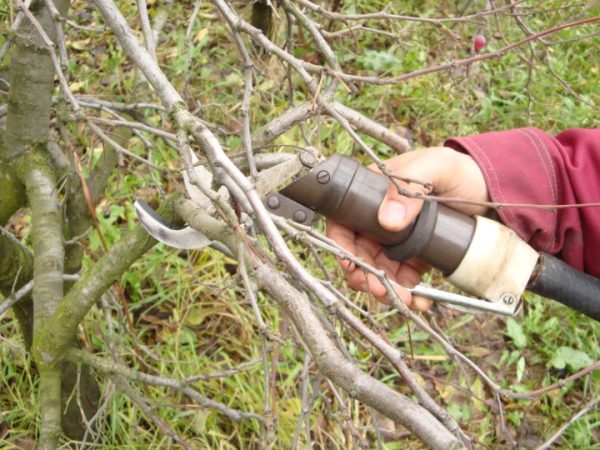

Timing
Autumn pruning should be done after the leaves that feed the plant before the onset of cold fall. In mild winters, it can be postponed until early November. It's okay if the first snow falls during this time.
Important! If you rush with autumn pruning, then root buds may awaken, which will lead to a decrease in crop yield in the next season.
In the spring, treatment should be done when it is possible to identify "live" buds to remove dead parts. This time usually falls in April. Optional summer pruning of annual shoots is done after the plant grows about 0.9-1 m (in May), and two-year-old after fruiting.
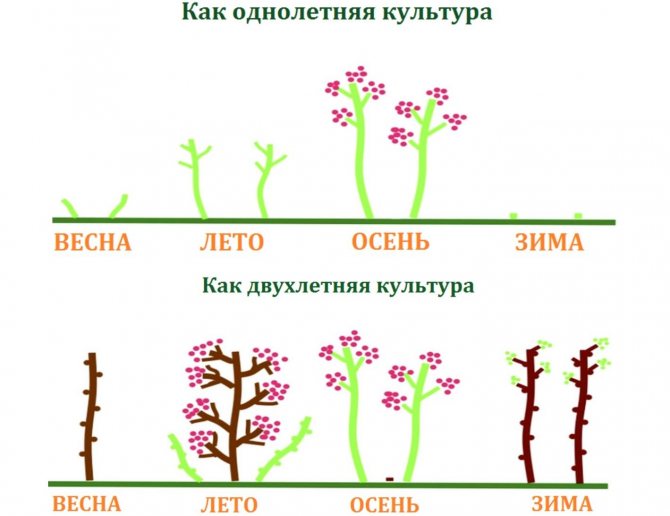

Why you need to cut raspberry shoots
Novice gardeners are tormented by the question of whether to cut raspberries in the fall. We answer: if you leave the shoots of the plant in full growth, then a decrease in yield and a decrease in berry size are guaranteed. Remaining dry shoots do not allow young shoots to grow. Pruning is required for all varieties of raspberries and promotes the appearance of new shoots in place of those that bear fruit. Plants over two years old are best removed.


It is important to control the distance between plants, the gaps are necessary for uniform sunlight and ventilation
Dense thickets directly affect the yield: a lot of greens - few berries. This also affects the taste - the sweetness disappears, giving way to a sour taste. Numerous pests do not deny themselves in the fragrant raspberry forest, which bring various diseases for the plant with them to a new place of residence. Young shoots, which are a consequence of the lack of pruning, do not have time to ripen and die even before the arrival of spring.
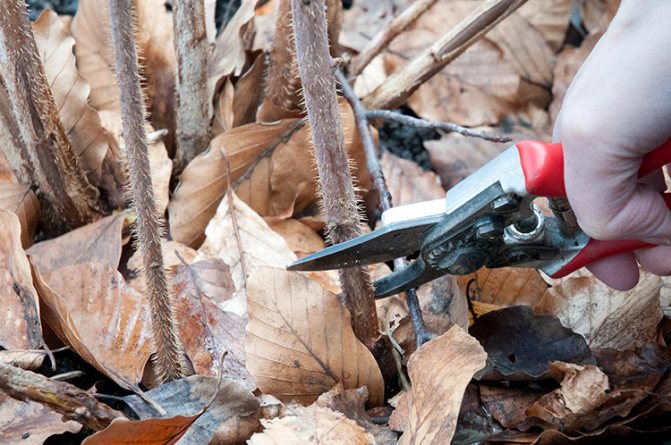

Pruning raspberries for the winter is a mandatory process that will provide you with a harvest of large and tasty raspberries.
Raspberry pruning scheme according to Sobolev
The Sobolev double pruning scheme is quite popular. Sobolev A.G. offered his own method, combining simplicity, efficiency and high-quality pruning. Pruning is done in two steps. In the spring, around the end of May or at the beginning of June, the usual height of the stems is already 80-90 cm.This means that you can cut off the tops by removing 15 cm each.
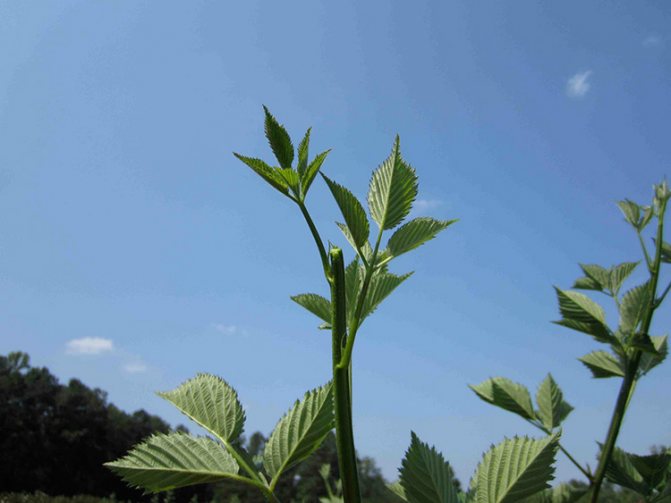

The tops are trimmed with pruning shears or simply pinched
The meaning of this action is to push a single shoot to branching, which will become full-fledged by the summer. In autumn it will be a strong bush with 5-7 sprouts of 0.5 m each.


Pruning is not carried out for the winter.
In the spring, the second stage of pruning begins: all the stems are shortened by the same 15 cm, allowing the bush to become even more branchy. Such lush bushes give many times more large berries, and the term of fruiting increases, approaching the timing of remontant raspberries. The disadvantages of the method include too dense planting of plants in the raspberry tree. Such bushes will be less ventilated, the sun will not be able to illuminate them evenly.
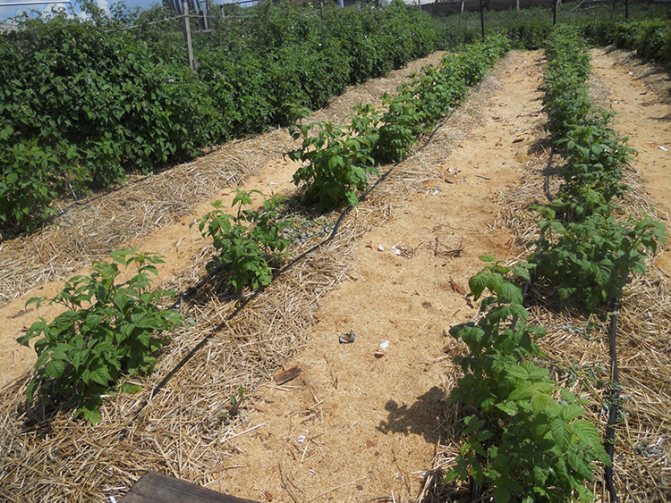

If you intend to grow raspberries according to the Sobolev method, then the distance between the bushes must initially be taken at least 2 m.The distance between the rows must be at least one meter
Due to the large branching, it is enough to leave 10 shoots in one bush in the first year, and then gradually reduce their number to 4.
Why is the procedure needed


Pruning raspberry bushes in the fall is done for the following reasons:
- The fruits of the culture are formed on stems no older than 2 years. From this it follows that the old branches are completely useless and must be cut to the ground. If you neglect this, then the raspberry will turn into impassable thickets and will produce very few berries.
- Autumn pruning is also needed for more convenient berry picking next year and for other work on caring for the raspberry tree. After pruning, there is more space, rows of plants are visible and intervals between plants are maintained.
- Pruning raspberries in the fall will get rid of pathogenic fungal spores and pests hibernating under the bark of raspberries. This is the key to the powerful development of raspberries next spring and the formation of a bountiful harvest.
Repaired raspberry varieties spend a lot of nutrition on the formation of berries, and this period lasts several months. To ensure the next year's harvest, it is necessary to rid the bushes of excess overgrowth before the onset of winter. Thanks to this autumn procedure, the roots will not waste precious nutrition on the growth and development of unnecessary shoots. Food will accumulate for future harvest.
A greater yield can be achieved not on bushes, which have many necessary and unnecessary shoots, but on properly cut raspberries.
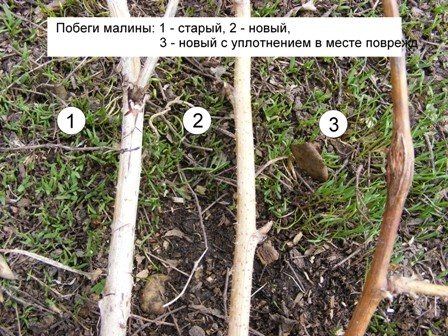

Gardener mistakes
Most budding gardeners often make mistakes when pruning raspberries. Most often, beginners make the following mistakes:
- It's a pity to cut off strong young growth - it seems to beginners that by cutting it, they deprive themselves of the future harvest. It is necessary to overcome this "psychological barrier" - without pruning, the plantings will hurt, the berries will become smaller, and the yield will fall. This is the biggest and most common mistake budding gardeners make.
- Not all branches are deletedto be trimmed. Beginners often start pruning from outside branches. Cutting out young shoots, they mainly remove the extreme shoots without going deep into the berry. As a result, the center of the raspberry tree becomes thickened - this leads to a decrease in yield and the appearance of diseases. Be sure to be patient and remove the shoots in the center of the plantings.
- Do not remove twisted branches... By not cutting branches that are close to each other and intertwined, gardeners increase the risk of disease. The branches, when they touch, lose their protective layer and become vulnerable to microbes.
- Incorrect pruning scheme... Often, gardeners only shorten the shoots, which should be cut off completely. They cut only dry and broken branches, and leave the rest. Sanitary pruning is not enough - formative pruning is also needed, on which the future harvest depends.
- Pruning damages the kidneys... To prevent this from happening, it is important to follow the pruning scheme. First, all large branches are removed, then those that are smaller. Then the pruning is faster and without kidney damage.
Cropping correctly
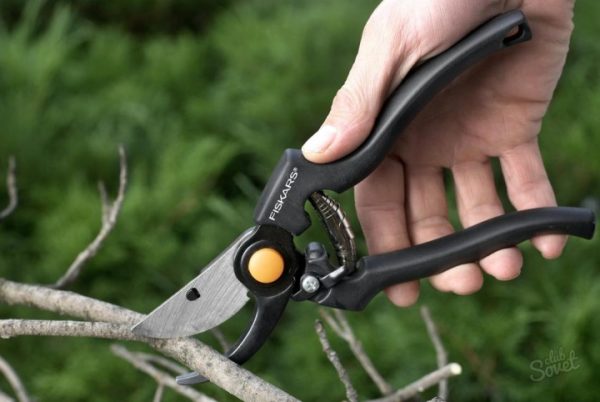

The peculiarity of the root system of this plant is that it is located on the surface. And this requires a more attentive attitude to the soil. You can get rid of weeds by mulching the soil.The second important point is the abundance of watering raspberries, and watering must be monitored all the time while the bush bears fruit. In order for the berries and the harvest to please in size and wealth, it is advised to fertilize raspberries in a timely manner with complex fertilizers. The optimal time for this is March, and for this use popular superphosphates or potassium sulfate. To prevent the appearance of fungal diseases, you can treat the bushes with Bordeaux liquid.
How to prune raspberries in the fall - step by step instructions
Raspberry pruning in different regions of the country is performed from early September to mid-November, 3 weeks before frost.
Pruning tools
Before starting the procedure, you should prepare and sharpen the necessary tools. Here's what we need to get started:
- Pruner. It must be well sharpened. Instead, you can use pruning shears designed for thorny shrubs.
- Garden knife. It is useful in difficult cases when the stems are cut unevenly.
- Lopper. It can come in handy on thick stems.
- Rake. They will find use when you need to remove cut branches and leaves from a raspberry patch.
Remember! Raspberries of ordinary varieties are not capable of forming a berry harvest on the shoots of the current year, flower buds can form only on two-year-old stems.
Pruning technique
Raspberry is represented by a perennial bush with a two-year development cycle. The crop is formed on stems that are 2 years old. In order for the culture to bear fruit annually, and the berries do not become small, it is necessary to systematically thin out the bushes and shorten the shoots.
As usual, autumn pruning is carried out in combination with the preparation of plants for winter. Cut off all the shoots that have borne fruit, as well as diseased and broken stems. Also, excess shoots of the current year are cut off under the base. All cut elements are then incinerated.


The procedure starts about 3 weeks before frost. To determine the exact date, it will not be superfluous to ask about the long-term weather forecast.
Over the summer, about 20 young shoots grow in one bush, and only 10 pieces need to be left after pruning.
Experienced gardeners are pruning bushes to different heights:
- 10 cm;
- 20 cm;
- 30 cm;
- half;
- by a quarter.
Thanks to this method, gardeners achieve smooth fruiting over the long summer period. Slightly shortened bushes are the first to bear fruit, and those stems that are greatly shortened will ripen later.
There is some expediency in combining pruning with winter preparation. For this, after the pruning procedure, the bushes are tied, bent and fastened together. In regions with harsh winters, the raspberry tree can be additionally covered with insulating materials.
Height of pruning bushes
This parameter depends on the age of the raspberry and its external state.
- Two-year-old stems are cut at the root, and annuals are cut in half.
- When pruning, the characteristics of the variety are also taken into account. Bushy and fast growing varieties are pruned shorter than others.
- The stems remaining after pruning should not rise more than 1.5 meters. Cultivars that produce abundant fruit in the first year are pruned at soil level, since new shoots will grow again in the spring.
To summarize briefly, the stems from which fruiting are expected for the next year are shortened, and the old ones are cut off completely. Young growth must be thinned out. In this way, the spread of cultural diseases can be prevented.
Upon completion of pruning, it is recommended to treat the remaining raspberry branches with a solution of phytosporin or ferrous sulfate to eliminate pathogenic microorganisms on the wood.
When to prune raspberries - fall, spring, or summer
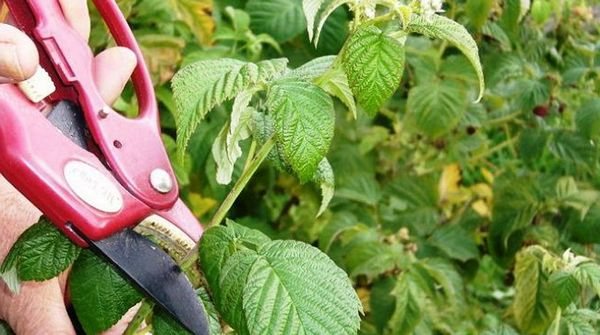

It is difficult to answer this question unequivocally. The fact is that in order to achieve good success, this procedure must be carried out several times during the season.An operation is performed in order to prevent too strong thickening of the bushes, for the timely regrowth of new shoots, on which sweet berries will then appear.
The development cycle of common raspberries is 2 years. Its bush consists of annual green shoots of the current year, there are no berries on them. The second group of shoots has a lignified appearance, they grew in the last year and it is on them that flowers and berries are formed.
A competent berry owner should engage in pruning common raspberry bushes three times during the summer:
- after the spring snow melt;
- after harvesting in summer;
- in the fall, 3 weeks before frost.
Pruning raspberries in spring
In the springtime, this trimming procedure is a kind of addition to the autumn procedure. It should be started when the snow melts and thawed patches appear. Before work, the bushes are carefully examined and all frozen and broken stems are cut out. Slightly frozen branches are pruned to a living bud.
If, upon examination, some of the stems seem sick to you, cut them off to the base. After pruning, about 8-10 strong stems should remain on the bush, the rest should be cut.
If raspberries occupy a large area in the garden, then you should strive to ensure that there are 2 meters between the rows of berries, and an interval of 1.5 meters should be maintained between the bushes in a row.
Pruning raspberries in spring is a ruthless cutting of all excess stems at the root. All remaining shoots are made shorter by 20 cm, cutting off their tops. The average height of the bush after the pruning procedure should be 1.5 meters.
Also noteworthy is the experience of some summer residents in spring pruning, due to which the ripening period of berries is extended over time. To do this, they divide all the raspberry bushes on the site into 3 groups and cut them in different ways.
Pruning raspberries in the fall - at what height is it carried out:
- for raspberries of the first group, pruning is carried out in the usual way, shortening the tops by 20 cm;
- in the second group of plants, the shoots are shortened by half;
- on raspberries of the third group, short pruning is done, leaving only 15 cm from the shoot.
The shorter the shoot, the later it will begin to yield. With this approach, the berries will ripen in stages from July to October.
Pruning young plants correctly when planting in a permanent location is also important. It is performed in the fall or spring. Such a pre-planting operation contributes to a better engraftment of the seedling. The branches of the seedling are pruned so that their length is 25 cm.
Pruning raspberries in summer
The plant grows strongly during the warm period, so it becomes necessary to prune it. Excess growth is removed. If numerous shoots stick out of the ground around the bush, they must be mercilessly removed. During the flowering period of the raspberry bush, it is necessary to remove yellowing leaves and shoots affected by diseases in time. They must be taken out of the site and burned.
In the summer, after picking berries, it is imperative to prune. All shoots that have already borne fruit are subjected to cutting. Cut them to the ground. This operation does not need to be postponed until later and should be carried out immediately after picking the berries. After pruning, the plant will direct all nutrition to young branches with fruit buds. Most often, such an operation is performed in August.
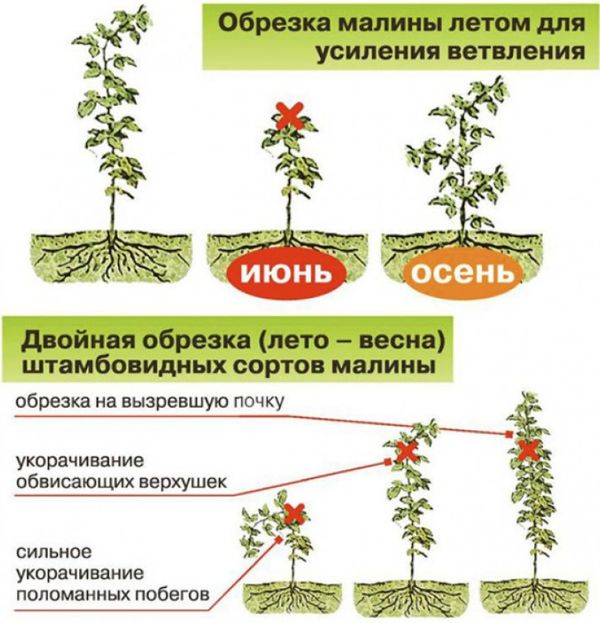

Important! The best planting scheme for raspberries is considered to be the one in which the row spacing is taken equal to 130 cm, and the spacing between plants is 100 cm.
Autumn raspberry pruning
Autumn pruning aims to prepare plants for winter. All stems that have completed fruiting are cut out. Sick, excess and broken stems are also subject to removal. Cutting is carried out at the root and everything that is cut from the bush must be burned.
The best time to carry out autumn pruning of raspberries is 20 days before the expected frost.
On average, each raspberry bush grows 20 shoots of the current year during the summer period.And in the winter, after a properly carried out pruning, about 10-12 of them should go away.
Autumn pruning is usually combined with preparing raspberries for winter. At the same time, the stems of the bush are grouped, bent and tied together so that they do not straighten out in winter. Some gardeners cover the bushes for the winter with insulating material, for which they use lutrasil or spunbond.
Attention! Repaired raspberry varieties differ from ordinary ones in that they bear fruit on the stems of the first and second years of life. Therefore, they have different pruning rules.
When in doubt whether you have a remontant raspberry or not
It often happens that we inherit the raspberry tree when we buy a plot. The former owners themselves do not always know which varieties of raspberries they grow - remontant or ordinary. But in any case, it is necessary to rejuvenate the bushes, otherwise you will not wait for a big harvest. In this case, proceed as follows:
- In the fall, cut off all shoots at ground level.
- In the spring and summer they look: there is a harvest on young shoots - it means that the raspberry is remontant, no - they are waiting for next year.
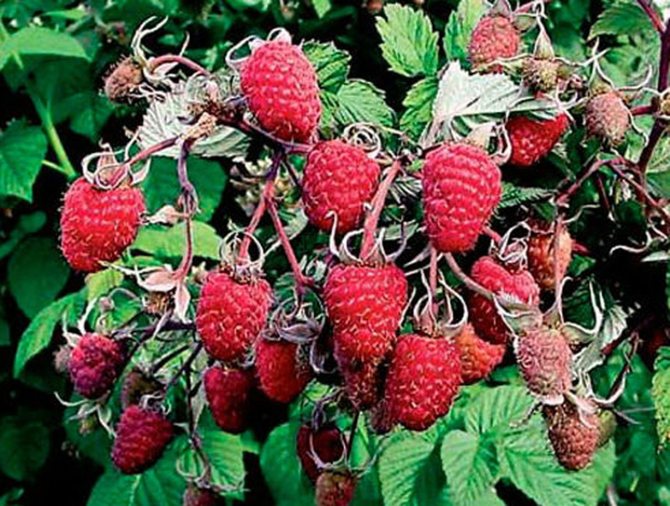

If raspberries yield a crop after pruning already in the current year, it means that they are remontant.
- And the next year, pruning is carried out in accordance with the type of raspberry.
Crop care after pruning
Above, we looked at how to properly prune raspberries in the fall. After completing the procedure, the bushes need little care, the essence of which is as follows:
- After the pruning procedure, it is necessary to do water-charging irrigation, which will allow the bushes to winter safely.
- To protect the remaining raspberry stems, especially remontant varieties, from winter freezing, it must be covered for the winter.
- To avoid moisture evaporation, cover the soil around the raspberry bushes with a mulch layer. Thanks to this agricultural technique, raspberry roots will be protected from freezing, which is most important in winters with little snow. Mulching is performed by:
- dried grass;
- fallen leaves;
- humus;
- peat;
- straw;
- bark of trees;
- sawdust.
- An equally important matter, after the autumn pruning of the shrub, is the feeding of raspberries. The applied fertilizers will help the bushes to be nourished with useful nutrients for the formation of the future berry harvest. For feeding, as usual, use:
- manure;
- humus;
- bird droppings;
- mineral fertilizers;
- a combination of organic matter and mineral oils.
Never apply fertilizers containing nitrogen before winter. This element will provoke the rapid growth of shoots to the detriment of the future harvest.
Many gardeners are engaged in the cultivation of raspberries, which are widespread in our country. She belongs to not very demanding cultures.
If watering, loosening, weed control, protection from dangerous pests and diseases are carried out on time, then you can rightfully count on a bountiful harvest of tasty and healthy berries. Also, our recommendations for pruning raspberries in the fall for beginners in pictures will help you get a decent result.
Section processing and further care
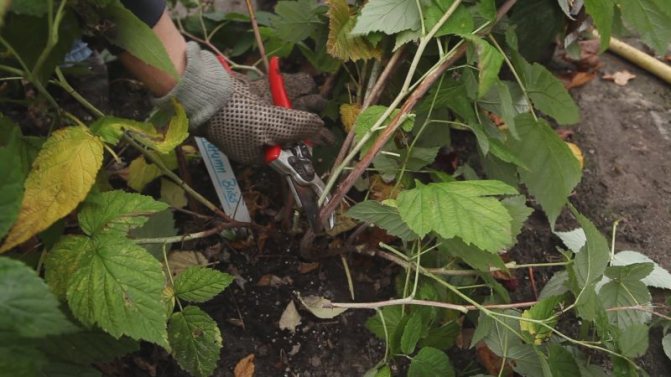

At the time of fruiting of remontant varieties of raspberries, the main pests of this culture go into hibernation, so the berries are not damaged by worms. Such varieties are extremely rare.
After cleaning, it is necessary to apply fertilizers to restore the strength of the plants. In autumn, it is recommended to use organic feeding: compost, diluted bird or rabbit droppings, rotted manure.
Repaired raspberries are very demanding on moisture. It is extremely important to carry out the autumn "charging" watering so that the bushes leave in the winter safely. If the autumn turned out to be dry, after pruning raspberries, they dig a trench 20-25 cm deep along the beds and fill it abundantly. The next day, planting is mulched with straw, sawdust, pine needles. The layer thickness is 15-20 cm, it is left until spring.
On a note! Drip irrigation is the best way to irrigate berries that are demanding on moisture during the flowering period.It requires minimal intervention from the gardener, but effectively moisturizes the deep soil layers in the rows.

